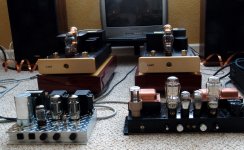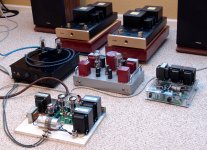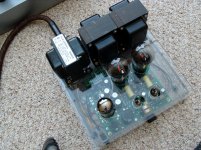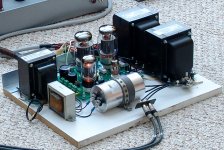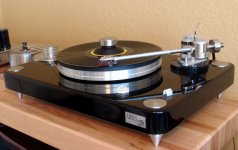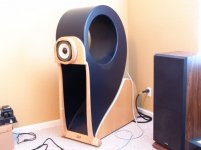Our audio gear is not for making music, it is for reproducing music which is a completely different thing.
Couldn't disagree more. Audio gear is for enjoying music. How we enjoy it is totally subjective (and it isn't always based solely on the sound coming out of the speakers). Unfortunately, not many people are comfortable with this fact and it leads to a lot of silly Internet debates about devices, topologies, etc.
Since the distortion we measure for speakers is pretty much meaningless (as is THD) that statement means nothing. ref Geddes & Alex from Raal
Certainly speakers (and mice/phono cartridges) are the furthest from perfection, but good electronics in front of them are very important. Even modest speakers with good amplification will typically outperform a great speaker with poor amplification.
dave
Thanks for the clarification, I shouldn´t have used THD to compare, what I wanted to point out was the fact that different speakers are much easier to distinguish/have a much bigger impact on sound than different amplifiers. And to clarify, when I say amplifier I mean a decent one, which is pretty easy to build either from SS or tubes, not a lousy portable radio amp.
Small-signal triodes are fairly linear, when used properly. Output triodes less so. To get accurate signal reproduction you need feedback. The fact that many tube amp fans hate feedback (because they don't understand it) tells us that accurate reproduction is not one of their aims. Once you know how to use feedback you are not restricted to devices with "linear amplification curves".planet10 said:Because tubes (triodes) have the most linear amplification curves of any devices (hard to find V-FETs are close), a well done tube amplifier can be one of the best sounding amplifiers available.
I enjoy music best when it is accurately reproduced. I happen to have a tube amp, but I choose to avoid 'tube sound'.Sodacose said:Couldn't disagree more. Audio gear is for enjoying music.
Last edited:
Thanks for the clarification, I shouldn´t have used THD to compare, what I wanted to point out was the fact that different speakers are much easier to distinguish/have a much bigger impact on sound than different amplifiers. And to clarify, when I say amplifier I mean a decent one, which is pretty easy to build either from SS or tubes, not a lousy portable radio amp.
Less distortion is more accurate but not necessary sound good. Some effect box have high distortion, it can change the sound timbre and make it sound good.
Aren't you the guy saying all amps sound the same?
No, but you seem to be the guy who seems to like to say false things and attack other people whose opinions are different from yours.
Tube amps that claim "tube sound" send me running because that usually implies the kind of sound we get from mediocre vintage kit.
It's reality. That seems to be what a large segment of that market wants.
Because tubes (triodes) have the most linear amplification curves of any devices (hard to find V-FETs are close), a well done tube amplifier can be one of the best sounding amplifiers available.
That's a myth, but it seems important to you to believe it. If tubes are so linear why is just about every device that measures nonlinear distortion SS?
Why is it that a $100 SS amp has far lower distortion than most tubed amps costing many times more?
Since they are typically pricey & tubes do wear out not as popular as SS stuff. A lot of SS stuff is crap. A lot of tube amps are crap too, but being simpler easier to modify (ie Chinese pre-built "kits")
Most people prefer their audio gear to perform properly as they buy it.
It is also important to consider the speakers they will be used with. Speakers & amp are a system and really need to be considered together.
An amplifier that only works with a tiny subset of all speakers has questionable value.
For HT, one will typically need a SS pre-amp (whether it has amps or not) as getting all the right decoding.
That's an odd way to justify the fact that if we were still locked into tubes, most modern audio technology would be impractical.
It is a fact that as long as we were locked into tubes, nobody ever made a commercial DAC that was completely implemented with tubes with much more than 11 bit accuracy http://www.analog.com/library/analogDialogue/archives/39-06/Chapter%201%20Data%20Converter%20History%20F.pdf page 23, figure 1,17.
A high precision tube DAC is a nightmare to design for many reasons including the operating temperatures and fact that the active components are continually degrading as they are used.
When I was in my 20s I maintained RADAR sets (AN/MPQ 39) that were bascially tubed wall to wall. They had about 400 tubes each, and even with highly expensive mil spec 25,000 hour tubes, their MTBF was about a day, which pretty well described how they actually worked.
I enjoy music best when it is accurately reproduced. I happen to have a tube amp, but I choose to avoid 'tube sound'.
Agreed, back in the day when tubes were all we had, the most highly regarded audio gear was striving for the best sonic and technical accuracy.
Since the distortion we measure for speakers is pretty much meaningless (as is THD) that statement means nothing. ref Geddes & Alex from Raal
Citing a nameless, credentialess audiophile does nothing for your argument.
Neither does misrepresenting Geddes who does post under his real name and have good credentials and track record.
Pretending that all speaker measurements are THD is just another misrepresentation.
At least there are some attributes which are strange because harder to reproduce with transistors like subjective dynamic or airy soundstage !
Is it a myth like the best DHT Preamp ? Noisy but with great musicality (H2?) ?
We often read as well than the best of the two worlds is Jfet at the input and tubes at the output and not the opposit often seen ...
I never read a real benchmark between the first watts of the Best Ncore designs VS the best sounding tubes amps on a same sota high sensivity peaker ! It will say a lot if they sound equaly well !
It will certainly no tell all the story as the speaker itself as everybody know is the less precise device in this combo. At the end as all is colored in the sense of a reproduction is never real, some will prefer the sound color of well designed tubes devices than the best SS ones !
Could it be the worst idea to enjoy the "color" of a DHT preamp by amplify it with a non colored Ncore amp, story to paint the sound at our own taste for instance ???
Better to let the worst reccordings sounding raw with a higher "acurate" combo like a Ncore after a DAC ? (at least, less is better is maybe an other myth...)
Is it a myth like the best DHT Preamp ? Noisy but with great musicality (H2?) ?
We often read as well than the best of the two worlds is Jfet at the input and tubes at the output and not the opposit often seen ...
I never read a real benchmark between the first watts of the Best Ncore designs VS the best sounding tubes amps on a same sota high sensivity peaker ! It will say a lot if they sound equaly well !
It will certainly no tell all the story as the speaker itself as everybody know is the less precise device in this combo. At the end as all is colored in the sense of a reproduction is never real, some will prefer the sound color of well designed tubes devices than the best SS ones !
Could it be the worst idea to enjoy the "color" of a DHT preamp by amplify it with a non colored Ncore amp, story to paint the sound at our own taste for instance ???
Better to let the worst reccordings sounding raw with a higher "acurate" combo like a Ncore after a DAC ? (at least, less is better is maybe an other myth...)
Last edited:
Agreed, back in the day when tubes were all we had, the most highly regarded audio gear was striving for the best sonic and technical accuracy.
But technical accuracy is an objective measure. How one enjoys music is subjective. It's creative marketing: telling consumers to focus on A (objective measurements) when what the consumers want to achieve is B (subjective enjoyment). Problem is that it's awfully hard to admit that the ways in which we enjoy music vary and at the same time claim that your product is the one best solution.
Nevertheless, it's this marketing folly that leads to the seeming hypocrisy that some 'audiophiles' prefer tube amplification despite higher distortion, lower bandwidth, less power, ad nauseam. The preoccupation with specs focuses on A, when what the users are trying to accomplish is B (ergo no hypocrisy exists, just differing goals).
I should note that I have nothing against SS and I do not believe that tubes are always better. Nor would I condemn any enthusiast that is in pursuit of the ultimate in measured performance (though I think that may be a hobby in and of itself). But, I do find the divisiveness stemming from this basic misunderstanding of individual goals distasteful and counterproductive (not singling you out, arnyk, these are general thoughts).
At least there are some attributes which are strange because harder to reproduce with transistors like subjective dynamic or airy soundstage !
Is "subjective or airy soundstage" a reliably salable attribute of audio gea, or just a subjective perception?
Hey ! Just ABX test could answer and of course with just two devices and the same reccording I'm not sure it tells the whole Truth !
I hadn't the luck to listen to the best devices of the two camps, so I'm biased twice !
I hadn't the luck to listen to the best devices of the two camps, so I'm biased twice !
They aren't good at causing the local seismic station to have its needles jump, or the neighbors calling the bomb squad at 3 AM.
Ask some of my ex - neighbors back in Florida about that......a 125 WPC tube amp through 96db speakers with 15 inch woofers playing Pink Floyd make the walls rattle...in the house across the street.
One can debate tubes VS solid state forever. This has already been going on for years, and it isn't going to be solved here.
I started out making tube amps in the 60's because tubes, transformers, and other parts were FREE, just snatch them out of all the discarded electronics at the local trash dump.
Through the 70's, and 80's I made solid state amps, again because the silicon was FREE, I worked at Motorola, I filled out a sample request, and I had free parts a week later.
The free samples went away, and by the late 90's Motorola was out of the discrete semiconductor business. I still got free chips from the National Semi rep, so I made several chip amps (that went away too), but I started building tube amps again. I have been making tube based HiFi and guitar amps for about 20 years since then.
Truth is that you can build a good sounding amp with any technology, AND you can build a bad one too. What sounds good to you might not appeal to the next guy.
I have several amps, all DIY, tube, discrete SS, chip amp, and Class D, in power levels from 2 WPC to 125 WPC. A 400 WPC tube amp is being designed. I listen to one for a while, grow tired of it, and swap in a different one. The two amps that get the most use are both low power tube amps (2 WPC DHT, and 8 WPC triode KT88).
I have taken my amps to dozens of listening tests and loaned them out often until they don't return (somebody buys it). A person who has listened to an iPod, a big HT system, or a ground pounding car stereo system for most of their life almost never likes a tube amp, even a big one. The person who attends live music events in small venues, even if it's rock music, is a likely candidate.
2A3 ? Have you ever heard a good Ncore as well ? I'm a little puzzled when I hear people saying they found the Graal with Ncore ! Have no oppinion myself about that, I don't sell adds though !
It calls a second discussion : high efficienty speaker (>94 dB?) !
Money choosed for me when I look at the price of a good output traffo !
It calls a second discussion : high efficienty speaker (>94 dB?) !
Money choosed for me when I look at the price of a good output traffo !
Last edited:
2A3 ? Have you ever heard a good Ncore as well
I have never been a fan of the 2A3. It does have a characteristic "sound" that many people like. My 2 WPC SET uses a pair of NX-483 tubes from 1929. They were FREE (that magic word again), pulled from a discarded Sparton radio.
Ncore, no, I rarely buy amps, I build them. My class D amps are built with TI chips. One is actually a TI EVM that was discarded at work it uses a TPA3110d2 chip, and the other is a home made PCB with a TPA3116 chip on it. I got some free chips from the TI rep before I "retired" from Motorola two years ago.
It calls a second discussion : high efficienty speaker (>94 dB?) !
Again, I have a collection of speaker all but one pair are DIY. Efficiencies range from 87dB (Yamaha NS-10's) to 96 dB (Hawthorne Silver Iris drivers in old console radio cabinets). The Yamahas are plenty loud in a small room with 2 WPC. The "radios" are 96db efficient and deafening with 125 WPC.
Picture shows the radio / speakers with the 2 watt SET on the table.
Attachments
Just ABX test could answer and of course with just two devices and the same reccording I'm not sure it tells the whole Truth !
I have a friend with some high priced stuff. We have done conventional listening tests at his place where everybody knows what's playing, and ABX testing with individual components, amp against amp in the same setup, and OPT against OPT in the same amp.
With everything known beforehand, and all but the equipment owner getting a vote, the results did often agree....until we swapped the record. In other words the amp most liked for Candy Dulfer wasn't the amp chosen for Pink Floyd. This is subjective testing....the ugly breadboard shouldn't have got any votes, but it did. We then used it for ABX (objective) OPT testing. The big Hammonds on it were dead last! It WAS pretty obvious
With ABX, often agreement could not be reached. We did an OPT test where two people picked Electra Print the best out of 5, and another person the worst out of 5 in the same amp. Average of 6 people picked them #2. What was it about them that caused one person to hate them? There were three VERY similar sounding OPT's in the test. They turned out to be the top three.
Even ABX testing carries user preferences along, unless you can get enough DIFFERENT people. We did several scientific studies on cell phone audio at work. It was determined that even 50 engineers is not a sufficient VARRIED sample (too many critical observers, and too many males). We had to go to the mall and ask for random volunteers, at least 30 before the results were considered valid, and then only for a 2 product comparison. They were either plain black plastic bricks, or identical appearing phones with different guts. Even product appearance can alter the results.
Some pictures of an amp test session
Attachments
Eh? If you are saying that an accurate amp (whether tube or SS) is not an FX box then most of us would agree.Eldam said:At least there are some attributes which are strange because harder to reproduce with transistors like subjective dynamic or airy soundstage !
'Hi end' audio marketing often does the opposite: it claims to offer subjective enjoyment (which may be true for some people, for various reasons) but then goes on to claim that the reason for this is that their chosen distortion is somehow closer to the original sound than a lesser (i.e. cheaper) item which simply reproduces the input signal at the output. The usual claim is that the 'hi end' item has less of certain unspecified immeasurable problems which more than compensates for its obvious weaknesses in specified measurable problems.Sodacose said:It's creative marketing: telling consumers to focus on A (objective measurements) when what the consumers want to achieve is B (subjective enjoyment).
An amplifier that only works with a tiny subset of all speakers has questionable value.
An amplifier only needs to work well with whatever speaker it is used with. The response above is inherent with those that believe that all amps should be voltage amps, completely disgarded potential performance gains with current amps.
The "world" is larger than just voltage amps.
dave
Pretending that all speaker measurements are THD is just another misrepresentation.
You said that, i didn't.
dave
'Hi end' audio marketing often does the opposite: it claims to offer subjective enjoyment (which may be true for some people, for various reasons) but then goes on to claim that the reason for this is that their chosen distortion is somehow closer to the original sound than a lesser (i.e. cheaper) item which simply reproduces the input signal at the output. The usual claim is that the 'hi end' item has less of certain unspecified immeasurable problems which more than compensates for its obvious weaknesses in specified measurable problems.
Good point DF. That's the same type of false equivocation (objective measurements can be used to predict subjective enjoyment).
Just to stir the pot, I'll add that the way a piece of gear looks (and the associations this engenders) carries a lot of weight with regards to how people perceive its performance. There's nothing wrong with that. If you need shiny bits to enjoy the music, who am I to say otherwise?
- Status
- Not open for further replies.
- Home
- Member Areas
- The Lounge
- Tube vs other


